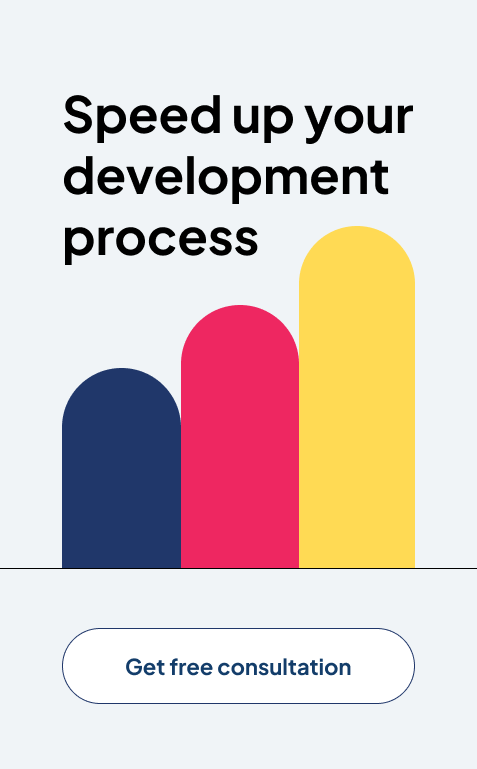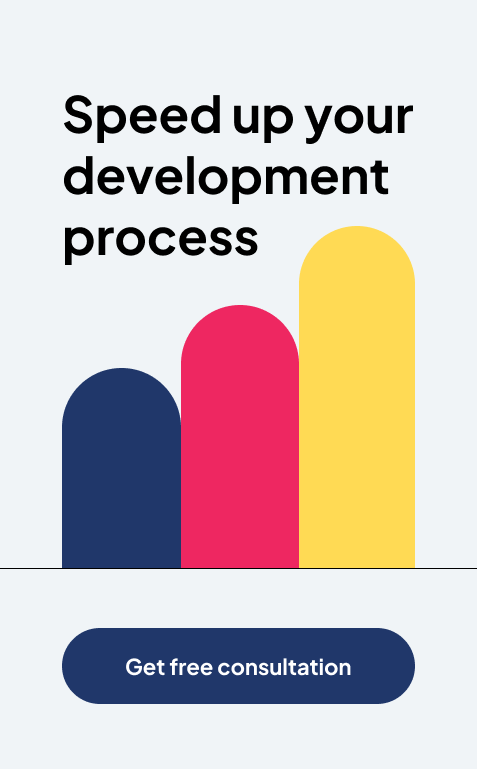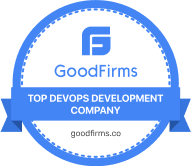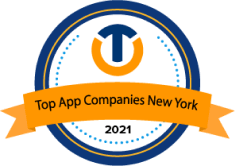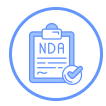How Long Does It Take to Build Custom Software?

Why is my team delivering software at a snail’s pace? Why do I always lag behind schedule with my project?
These are common questions in the software development world. Today, businesses need more custom solutions to stay competitive.
Once you have a good enough idea, you can think about making it a reality. But things don’t happen instantaneously.
Software development isn’t just a few lines of code. It involves many less glamorous but critical tasks. These are test planning, code reviews, and more.
That’s why, giving precise software estimates is tough. But there are ways to figure it out. Let’s go over everything involved in this process.
What is Estimation in Software Development?
A software estimation is the time to begin and finish all development tasks. Teams assess various parameters to arrive at it. The major ones are:
- Team size and experience
- Software type and complexity
- Accessibility of the tech stack
- The necessity of additional expertise
- Meeting of the interim outcome with the customer
- Refinement
- Custom design solutions
- Adding extra tasks related to development
What is a Custom Software Development Timeline?
A custom software development timeline shows the plan and time for tasks. It breaks down the entire process into small parts. A timeline guides the team to adjust to any project changes. It ensures that your team delivers the software within the set timeframe. This timeline works for software of all sizes, whether big or small. Below are the various parts of this timeline.
Product Discovery (4-8 weeks/1-2 months)
Product discovery is the very first step. It verifies your idea. You can then brainstorm on how to implement it. In this stage, you discuss the scope of your solution. It means the problem that your product will solve. You also research your target market. This helps you find out the exact requirements of your project.
A product discovery stage lets you determine:
- Project deliverables
- Software functionalities
- The tools and tech stack you need
- Development checkpoints
- Proficiency in building your app
- A general idea of the expenses and the time.
Software Design (9-13 weeks/2-3 months)
In this phase, you design the software. This task consists of various activities. These are:
- A deep market research
- Mapping out the user journey to complete a task in your software.
- Wireframing
- Creating a static visual representation of your product
- Building a prototype
- Testing the product with the end user.
The software design process takes place in two parts. These are:
- User experience design: 2-3 weeks
- User interface design: 3-4 weeks
This time increases or reduces based on the complexity of your product.
Building the Software (12-24 weeks/ 3 to 5.5 months)
This part breathes life into your idea. Now, software developers take the reins from designers. They convert the design into a functioning product. This phase is longer because it materializes your software vision. This phase has two parts, both of which demand equal time. These include your product’s front end and back end. To reduce the time, you can develop both the front and backend together.
Software Testing (2-3 weeks/ 1 month)
Testing is critical for a successful launch. The time taken by this stage can stretch based on how many issues are present in the software. Remember, if there’s a major issue, it can halt your project’s progress. Teams may need to go back to the development stage. This can stretch your timeline.
A great way to prevent this is to incorporate QA from the moment development begins. It will ensure that you detect bugs early. You can then take the right measures to fix it. The sooner you detect an issue, the cheaper it is to eliminate it. Another best practice is to use automated testing tools. Tools like Selenium and Cypress constantly test the software. They ensure that you continue development without harming quality.
Types of Project Timelines
There are various types of project timelines. Choosing the right one is key to successful completion. Below is a quick overview of these different timelines.
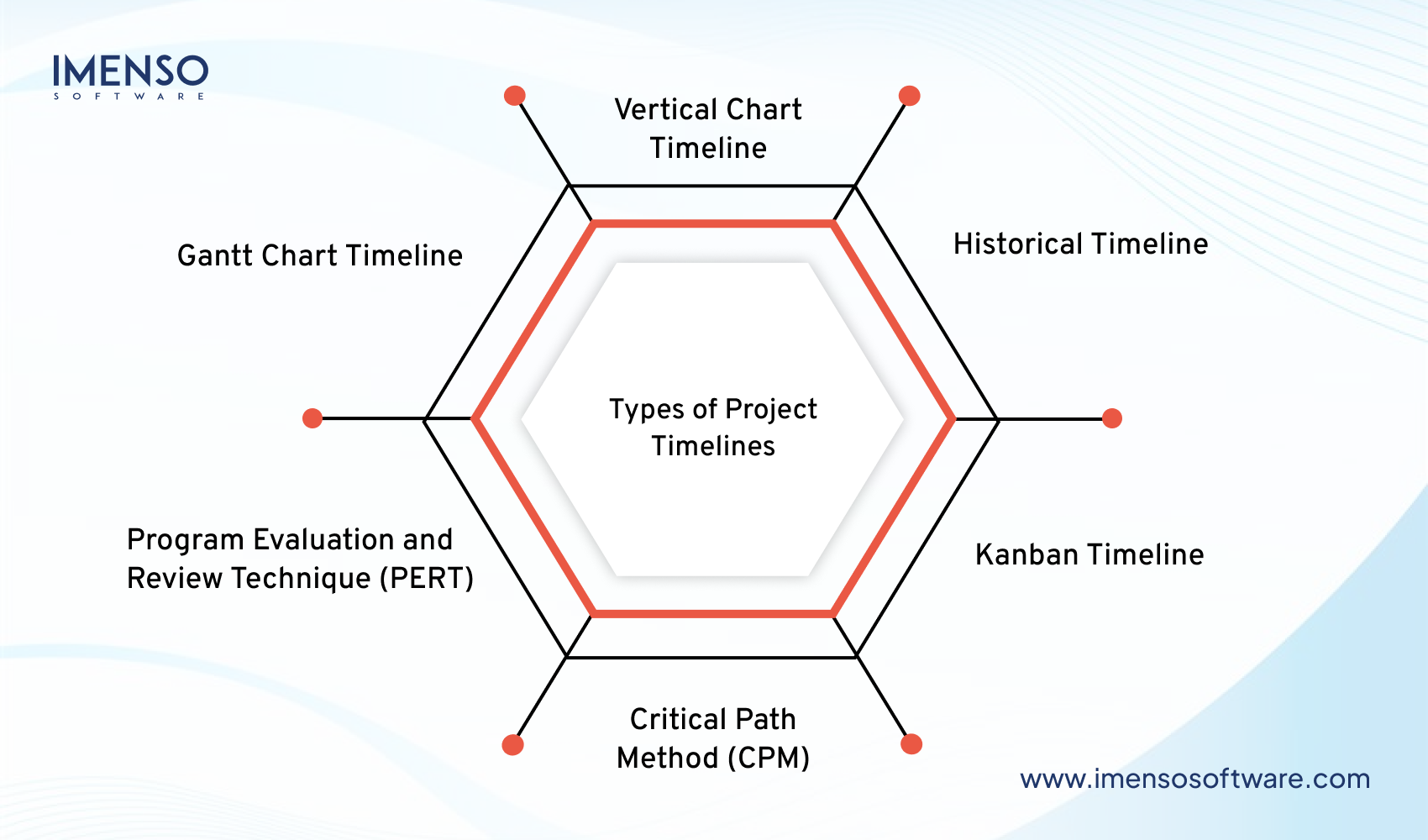
1. Gantt Chart Timeline
A Gantt chart is a timeline tool that gives a visual overview of tasks. It shows all the activities you’ve planned. You can see when various project stages begin and end. Thus, it helps you manage time efficiently. You can also spot potential issues in your project.
When to Use Gantt Charts
Gantt charts are ideal for projects that require a clear, linear timeline. If you can easily visualize tasks and dependencies in your project, a Gantt chart will be a good timeline choice. Some examples where they are effective are:
- Traditional waterfall projects
- Construction and manufacturing
- Business plans and product management
- Complex projects with task dependencies
2. Vertical Chart Timeline
It’s a version of Gantt chart project management. It shows tasks along a vertical line. If you have a small project or need a concise task list, a vertical chart timeline can help.
When to Use a Vertical Chart Timeline
If you have a data-centric project for finance or marketing, use this timeline. It can illustrate project progress over a defined timeframe.
3. Historical Timeline
A historical timeline outlines key events linearly. It is quite helpful in complex projects. A historical timeline simplifies the visualization of project stages.
When to Use a Historical Timeline
This timeline showcases project tasks in order. The following projects can benefit from it:
- Education and research projects. Examples include museum exhibits and history projects.
- Biographical timelines
- Marketing and product development
4. Kanban Timeline
Kanban timelines focus on the progress of tasks from being in progress to being completed. If you follow an Agile approach, this timeline will suit you.
When to Use Kanban Timeline
This timeline is especially suitable for projects with continuous work. Below are some projects that can benefit from it.
- Software development
- IT operations
- Marketing
- Product development
Must Read: Agile vs. Scrum vs. Kanban: Which Methodology is Best for Your Software Project
5. Critical Path Method (CPM)
This approach spots the sequence of interdependent tasks. These tasks impact a project’s timeline. CPM is suitable for complex projects that require strict time tracking and planning.
When to Use CPM
Projects with tight deadlines benefit from CPM. Here are some examples of projects that can use this approach.
- Construction
- Software development
- Manufacturing
- Aerospace and defense
6. Program Evaluation and Review Technique (PERT)
PERT focuses on the time taken by each task. If you are working on a project where software estimation is tough, PERT can help. It factors in uncertainty in providing an accurate timeline.
When to Use PERT
Big, complex, one-time projects are ideal for PERT. Here are some use cases of this technique.
- Research and development projects
- Construction projects
- Event planning
- Movie production
Example of a Project Timeline
Let’s understand the project timeline better with the help of an example.
Project Title
Real Estate Management System
Overview
The project seeks to develop a real estate management software. The client is a property management firm. The software should be able to handle property listings and tenant data. It should manage lease agreements and financial transfers. The timeline estimate is six months.
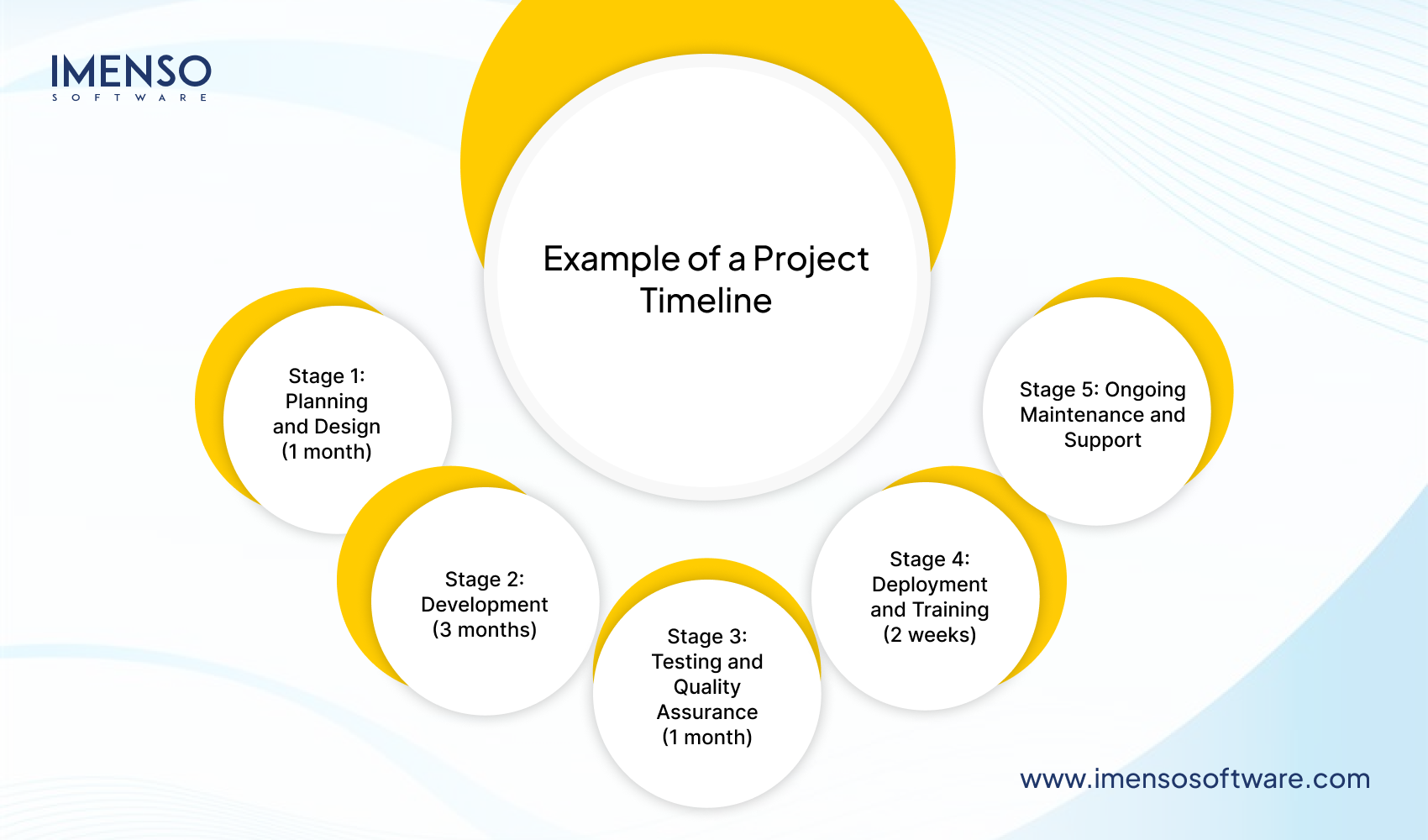
Stage 1: Planning and Design (1 month)
– Collect requirements from the stakeholders.
– Do a deep market research. This helps you assess current similar software.
– Create a project plan. It should be clear with checkpoints and deliverables.
– Design the UI and database structure.
Stage 2: Development (3 months)
– Develop the basic features. These can be property listing management, tenant data, etc.
– Create a simple interface for easy navigation.
– Integrate a secure payment gateway.
– Test regularly
– Coordinate with the client for feedback. On its basis, make the changes.
Stage 3: Testing and Quality Assurance (1 month)
– Conduct thorough testing. This helps spot and fix any bugs.
– Do stress testing. It will clarify if the system can handle a greater volume of data and users.
– Test the compatibility of the software with various devices.
– Conduct user acceptance testing. This is critical for feedback.
Stage 4: Deployment and Training (2 weeks)
– Prime the system for deployment on the server of your client.
– Give the end users training to use the system.
– Address issues raised during training.
Stage 5: Ongoing Maintenance and Support
– Offer ongoing maintenance and support for the system.
– Fix any user queries that occur after the launch.
– Regularly review the system’s performance. Also, monitor its security.
Why Is Estimation in Software Development So Hard?
A study by HBR found that one in six software projects overspent by over 200%. They were also late by 70%. A McKinsey study found that IT projects have cost overruns by 45%. They are 7% over schedule. The situation is worse for large projects. Those with budgets over $15M overspend by 66% on average. They have schedule overruns by 33%.
All of this begs a question.
Why are software estimates so painfully hard?
Suppose you know the rules of chess. There’s a chessboard in front of you. A game is underway. You are told that white can mate in three moves. How much time will you need to uncover what those three moves are? After all, you know the rules and how the pieces move. You also know what the board looks like right now. You have everything you need to make an accurate guess. But you still can’t estimate it. Software development is no different.
Below are various reasons why giving an exact timeline is hard. We’ll also tell you how to tackle them.
1. Estimating Before Defining the Project Scope
Teams usually talk about the time way earlier. Timeline discussion should only happen after defining the project scope. You need to grasp the project’s complexity first. So, instead of jumping to an estimate, break down the project into modules. Define assumptions. In other words, have structural clarity.
2. Considering Early Estimates as Set in Stone
Clients regard an early software estimate as final. This isn’t the right way to go. Early timeline forecasts are based on minimal data. You must represent every estimate in a range. For example, instead of 4 months, say 4-8 months. This will factor in the risks and uncertainties that may arise.
3. Teams Lack Data on Past Project Performance
Estimation becomes hard if you don’t have past data. It is likely that you can give wrong estimates to your client. To prevent this, build a knowledge base of reference estimates. On their basis, you can make better predictions. It also lowers uncertainty to a great extent.
4. Hurrying up Software Delivery
Speeding up delivery comes at the cost of losing quality. Here’s the truth. If you really want your software in a short time, do less. It means making it a lesser version of what you envisioned. The only other way you can expedite delivery is by spending more.
5. Complexity Inherent in Maintenance and Enhancement Projects
Improving a legacy system is much harder than new builds. These are tougher to estimate. There are structural constraints to these systems. You need more effort to integrate a new feature into them. The best way to go about it? Use a mix of reasoning based on analogy and past data. Do not estimate them based on new builds.
Any effective software estimation technique has two characteristics. It captures both time and uncertainty.
– Jacob Kaplan-Moss, software developer, co-creator of Django
What Is the Best Way to Estimate Software Development?
The best estimate factors in uncertainty. Planning based on this core element helps you give the most accurate estimate. Below is an effective approach to give a realistic estimate.
1. Define the Full Scope of the Project
Before anything, you must define the project scope. Sit with your client and discuss everything. This includes their business goals and technical needs. Talk about potential obstacles and risks. Don’t hold back asking anything that might give unpleasant surprises later.
Break down the project into small chunks. For example, features, processes, and integrations. You must be fully aware of the idea and its intended aim.
2. Turn the Project into Actionable Steps
Now you know the high-level needs of the project. Turn them into actionable steps. It means breaking down the project into work units. Through this, you can assess how much effort you will need. It will also help you spot technical dependencies earlier.
This part helps you do three things, which are critical for estimation. These are:
- Optimize effort allocation
- Plain the timeline
- Assess risk across all development stages.
3. Tap Into Historical Data
You cannot give accurate software estimates without any past record. It’s always good to build a hub of past project data. This helps you make informed decisions. You’ll have an idea of the issues you can face and how to fix them. By going over this record, you can set benchmarks for new estimates against real-world projects. Having a repository of such data greatly reduces uncertainty.
4. Include Buffer Time and Risks in Your Estimate
In life, nothing goes exactly as planned. Software development is no different. No matter how much you plan, hurdles will arise. Your priorities can change, leading to delays. So, it’s crucial to include risk buffers in your estimate. A buffer of 10-20% based on your project’s complexity and uncertainty can help. Always plan for the unpredictable. This will keep you agile and your project on track.
5. Collaboration with Everyone Involved
A software estimation is always a team effort. An accurate one can happen only when everyone is involved. This includes developers, project managers, and the client. It helps ensure that technical feasibility and delivery capacity are taken into account. Bringing together everyone allows you to give an estimate that is more aligned with how you will carry out the project in reality.
Useful: Offshore Software Development Services
How to Improve the Accuracy of Software Estimates Over Time?
The key to improving the accuracy of a software estimate in the long term is by tracking KPIs. They help you quantify how your project is performing. KPIs also enable you to gauge the project’s progress. Below are some critical ones.
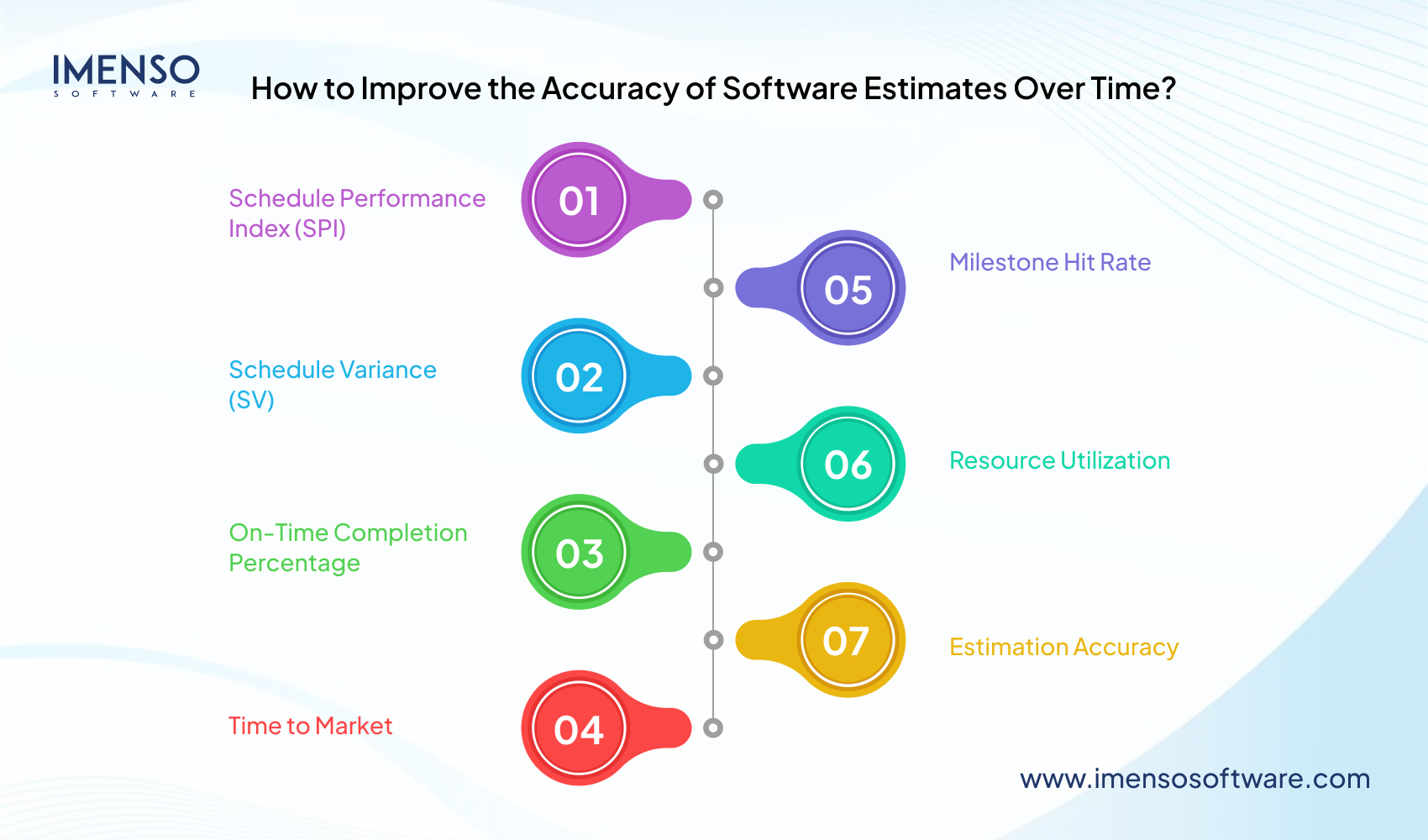
a. Schedule Performance Index (SPI)
- Formula: Earned Value / Planned Value
- Interpretation: SPI > 1 shows that you are ahead of schedule. SPI < 1 signals that you are behind your schedule.
b. Schedule Variance (SV)
- Formula: Earned Value – Planned Value
- Interpretation: Positive SV represents ahead of schedule. A negative SV shows that you are behind schedule.
c. On-Time Completion Percentage
- Formula: (Number of tasks done on time / Total number of finished tasks) x 100
- This KPI lets you track consistency in fulfilling task deadlines.
d. Time to Market
- Measures the time from the time that the project begins to delivery.
- This KPI is critical for projects where speed to market is crucial.
e. Milestone Hit Rate
- Formula: (Number of milestones accomplished on time / Total number of milestones) x 100
- Tracks success in attaining key project milestones.
f. Resource Utilization
- Formula: (Real working hours / Available hours) x 100
- Helps spot over- or under-utilization of resources.
g. Estimation Accuracy
- Formula: (Estimated time / Real time) x 100
- Helps refine future software estimations.
Sharpening Your Software Estimates
An accurate software estimate is a result of assessing many factors. By remembering every factor in this post, you can be more precise in your estimate. Team and client collaboration is a pillar to align your project with the expectations. As a side practice, keep yourself updated with the latest tech advances. Most of all, appreciate the process as each project makes you learn various lessons.
Frequently Asked Questions
- How long does it take to design software?
On average, software design takes 8 – 12 weeks. In this time, 2-3 weeks are spent designing the user experience. The remaining 3-4 weeks are for user interface design.
- How long does engineering design take?
The time depends on the product’s complexity. If it’s a simple product, the time can range from 1-8 weeks. This is the time for engineering. It is also spent on designing manufacturing files. Then, prototyping occurs from 2-4 weeks.
- How long does it take to implement a new software?
Software implementation time varies from a few weeks to many months. Various factors are behind this. These consist of the IT project’s scope and complexity. It also depends on the organization’s preparedness. Teams can implement small software in 1-4 weeks. Big systems can take 6 months or more.
- How long does it take to build software?
The cost can range from $40,000 to $400,000 or more. The final amount depends on various factors. The major ones are the project’s complexity and the tech stack needed. Other factors consist of the needed feature set and domain-specific requirements.
Want more information about our services?
Similar Posts
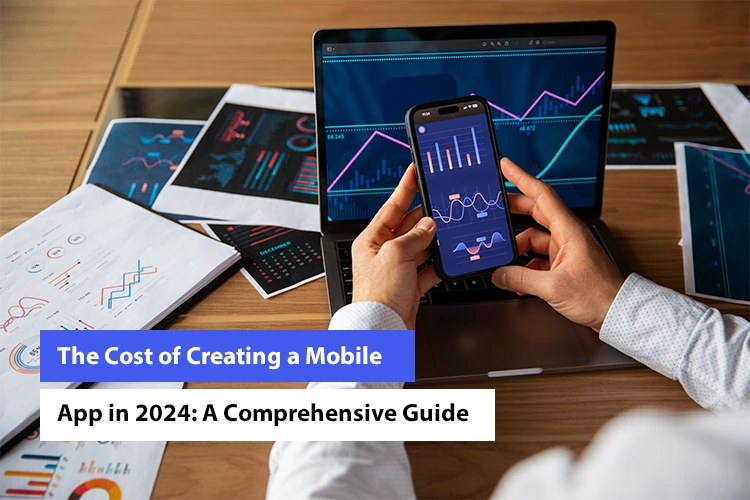
How much does it cost to create an app in 2024 – A Detailed Guide
Ever wondered what it takes to turn your brilliant app idea into a reality? How much does it truly cost to create an app that captivates users and brings value to their lives? As the digital era accelerates, mobile app development has become a powerhouse, shaping industries and driving innovation. Did you know that by […]...

10 Reasons Why Vue.js Is Best for App Development
Are you tired of sifting through endless JavaScript frameworks and libraries in search of the perfect one for your app development project? Look no further! Vue.js is here to save the day (and your sanity). But seriously, Vue.js has gained a loyal following among developers for good reason. It’s a powerful and versatile framework that […]...

Is Shopify the best eCommerce Solution for your Business in 2021?
Starting an online store is a challenge. Doing it for the first time is even harder. An eCommerce business is a great idea as it takes your products and services to millions of customers over the internet. ...
